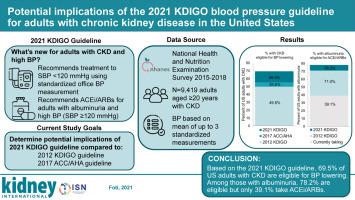Kidney International ( IF 14.8 ) Pub Date : 2021-02-23 , DOI: 10.1016/j.kint.2020.12.019 Kathryn E Foti 1 , Dan Wang 1 , Alexander R Chang 2 , Elizabeth Selvin 1 , Mark J Sarnak 3 , Tara I Chang 4 , Paul Muntner 5 , Josef Coresh 1

|
The 2021 Kidney Disease: Improving Global Outcomes (KDIGO) Clinical Practice Guideline for the Management of Blood Pressure in Chronic Kidney Disease (CKD) recommends a target systolic blood pressure under 120 mmHg based on standardized office blood pressure measurement. Here, we examined the potential implications of this new guideline for blood pressure lowering with antihypertensive medication among adults in the United States with CKD compared to the 2012 KDIGO guideline (target blood pressure 130/80 mmHg or under with albuminuria or 140/90 mmHg or under without albuminuria) and the 2017 American College of Cardiology/American Heart Association (target blood pressure under 130/80 mmHg) guideline. Additionally, we determined implications of the 2021 KDIGO guideline for angiotensin converting enzyme inhibitor (ACEi) or angiotensin II-receptor blocker (ARB) use for those with albuminuria (recommended at systolic blood pressure of 120 mmHg or over) compared to the 2012 KDIGO guideline (recommended at blood pressures over 130/80 mmHg). Data were analyzed from 1,699 adults with CKD (estimated glomerular filtration rate 15-59 ml/min/1.73m2 or a urinary albumin-to-creatinine ratio of 30 mg/g or more) in the 2015-2018 National Health and Nutrition Examination Survey and averaged up to three standardized blood pressure measurements. Among adults with CKD, 69.5% were eligible for blood pressure lowering according to the 2021 KDIGO guideline, compared with 49.8% as per 2012 KDIGO or 55.6% as per 2017 American College of Cardiology/American Heart Association guidelines. Among those with albuminuria, 78.2% were eligible for ACEi/ARB use by the 2021 KDIGO guideline compared with 71.0% by the 2012 KDIGO guideline. However, only 39.1% were taking an ACEi/ARB. Thus, our findings highlight opportunities to improve blood pressure management and reduce cardiovascular risk among adults in the United States with CKD.
中文翻译:

2021 年 KDIGO 血压指南对美国成人慢性肾病患者的潜在影响
2021 年肾脏病:改善全球结局 (KDIGO) 慢性肾脏病 (CKD) 血压管理临床实践指南建议根据标准化诊室血压测量将目标收缩压控制在 120 mmHg 以下。在此,我们研究了这一新指南对美国 CKD 成人患者使用抗高血压药物降低血压的潜在影响,并与 2012 年 KDIGO 指南(目标血压 130/80 mmHg 或以下伴蛋白尿或 140/90 mmHg 或没有蛋白尿)和 2017 年美国心脏病学会/美国心脏协会(目标血压低于 130/80 mmHg)指南。此外,我们还确定了 2021 年 KDIGO 指南对蛋白尿患者使用血管紧张素转换酶抑制剂 (ACEi) 或血管紧张素 II 受体阻滞剂 (ARB) 的影响(建议收缩压为 120 mmHg 或以上),与 2012 年 KDIGO 指南相比(建议血压超过 130/80 mmHg 时使用)。数据分析来自2015-2018年全国健康与营养检查中的1,699名成年CKD患者(估计肾小球滤过率15-59 ml/min/1.73m 2或尿白蛋白与肌酐比值30 mg/g或以上)调查并平均最多三个标准化血压测量值。根据 2021 年 KDIGO 指南,在患有 CKD 的成人中,69.5% 的人符合降血压的条件,而根据 2012 年 KDIGO 指南,这一比例为 49.8%,根据 2017 年美国心脏病学会/美国心脏协会指南,这一比例为 55.6%。在蛋白尿患者中,根据 2021 年 KDIGO 指南,78.2% 的人符合使用 ACEi/ARB 的条件,而根据 2012 年 KDIGO 指南,这一比例为 71.0%。然而,只有 39.1% 的人服用 ACEi/ARB。 因此,我们的研究结果强调了美国成人慢性肾病患者改善血压管理和降低心血管风险的机会。











































 京公网安备 11010802027423号
京公网安备 11010802027423号